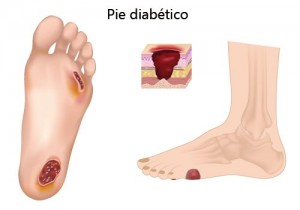
Dentro de las complicaciones que surgen de la diabetes una de las más comunes es la conocida como el Diabetic foot,,es,how to prevent this dreaded complication,,es,Among the complications that arise from diabetes one of the most common is known as the Diabetic Foot,,es,which can cause many health problems for patients,,es,it is included,,it,the possibility of gangrene or amputation of the leg,,es,Over time,,es,high levels of blood sugar can damage the nerves and / or blood vessels of the lower extremities,,es,what negatively affects sensitivity,,es,mainly of feet and legs,,es, el cual puede ocasionar muchos problemas de salud a los pacientes, e incluso, la posibilidad de una gangrena o amputación de la pierna.
Con el tiempo, los altos niveles de azúcar en la sangre pueden dañar los nervios y/o vasos sanguíneos de las extremidades inferiores, lo que afecta negativamente la sensibilidad, fundamentalmente de pies y piernas, and accelerates arteriosclerosis by decreasing arterial blood flow,,es,These alterations facilitate that a minimum traumatism or wound causes ulcers difficult to heal,,es,that can cause serious infections and pain that,,es,of not being treated on time,,es,can cause significant necrosis or gangrene requiring amputation of the leg,,es,It is estimated that,,es,of patients with diabetes present at some point in their life compatible lesions with a diabetic foot,,es,while,,es.
Estas alteraciones facilitan que un mínimo traumatismo o herida provoque úlceras de difícil cicatrización, que pueden originar infecciones graves y dolores que, de no ser tratados a tiempo, pueden causar una necrosis o gangrena importante que requieran la amputación de la pierna.
Se estima que el 15% de los pacientes con diabetes presentan en algún momento de su vida lesiones compatibles con un pie diabético, mientras que 80% of those suffering from this condition have altered sensitivity,,es,and these are the most likely to develop ulcers,,es,What causes diabetic foot,,es,The most important factors for the development of this condition are,,es,The poor control of diabetes that produces neuropathy and accelerates arteriosclerosis,,es,Peripheral neuropathy,,es,a diabetic patient with this complication can walk with a foreign body inside the shoe and does not feel it,,es,with the risk of producing an ulcer that is difficult to heal,,es, y estos son los más proclives a desarrollar úlceras.
¿Qué causa el Pie Diabético?
Los factores más importantes para el desarrollo de esta condición son:
– El mal control de la diabetes que produce la neuropatía y acelera la arteriosclerosis
– La neuropatía periférica, literalmente, un paciente diabético con esta complicación puede caminar con un cuerpo extraño dentro del zapato y NO lo siente, con el riesgo de producir una úlcera de difícil cicatrización
– Foot deformities,,es,Charcot arthropathy,,gl,that they favor that until the friction of the footwear in that foot with diminished sensitivity it produces an ulcer and potentially a gangrene,,es,Arteriopathy,,es,which is the hardening of the arteries by the internal accumulation of cholesterol plaque produced by arteriosclerosis and which complicates or makes impossible the healing of an ulcer,,es,The consumption of tobacco or cigar,,es,First symptoms of the Diabetic Foot,,es (artropatía de Charcot) que favorecen que hasta el roce del calzado en ese pié con sensibilidad disminuida produzca una úlcera y potencialmente una gangrena
– La arteriopatía, que es el endurecimiento de las arterias por la acumulación interna de la placa de colesterol producida por la arteriosclerosis y que complica o hace imposible la cicatrización de una úlcera
– El consumo de tabaco o cigarro
Lea también: Masajes para prevenir y eliminar várices ¡Un secreto bien guardado!
Primeros síntomas del Pie Diabético
Los primeros signos que deben alertar sobre el inicio de un pie diabético son el enrojecimiento de algunas zonas del pie, el aumento de su temperatura, zonas callosas que no mejoran, y que finalmente se  ulceran.
ulceran.
Estas lesiones iniciales pueden progresar hasta llegar a una úlcera profunda y alcanzar el hueso provocando una infección (osteomielitis), y finalmente en situaciones muy avanzadas una gangrena del pie.
Con un buen seguimiento y control médico previo estas lesiones se pueden evitar. Los pacientes diabéticos deben ser examinados con periodicidad por un médico especialista, y deben ser educados para una correcta higiene y cuidado de sus pies.
¿Cómo evitar el Pie Diabético aunque seas diabético?
El control estricto de los niveles de azúcar en la sangre y del resto de factores de riesgo de arteriosclerosis, mencionados anteriormente, disminuyen notablemente la incidencia de estas complicaciones.
Además, the diabetic patient must take a series of precautions for the good care of their extremities and prevent blows or traumas that can cause ulcers,,es,Recommendations for the care of your feet,,es,Be careful when cutting nails,,es,If necessary, go to a podiatrist,,es,Do not walk barefoot,,es,View comfortable socks and shoes at all times,,es,Check the water temperature before submerging the feet,,es,remember that the neuropathy may have altered the sensitivity and feel warm hot water,,es. Recomendaciones para el cuidado de sus piésNo caminar descalzo. Vista medias y zapatos cómodos en todo momento.
-
- Comprobar la temperatura del agua antes de sumergir los pies, recuerde que por la neuropatía puede tener alterada la sensibilidad y sentir tibia el agua caliente, even better,,es,avoid ¨remojar¨ your feet,,es,Use moisturizers to keep the skin moist and soft,,es,dry skin promotes infections,,es,Check and wash your feet every day to avoid infections,,es,Limit calluses and calluses gently without causing breakage,,es,Perform a constant diagnosis of the condition of the feet with their hands and if their vision is diminished,,es,ask a family member to do it for you,,es,Protect your feet from the cold and heat,,es,In the same way,,es, evite ¨remojar¨ sus pies.
- Utilizar cremas hidratantes para mantener la piel húmeda y suave, la piel reseca favorece las infecciones.
- Revisar y lavar sus pies todos los días para evitar infecciones.
- Limar los callos y callosidades suavemente sin provocar roturas.
- Realizar un constante diagnóstico del estado de los pies con sus manos y si su visión está disminuida, solicitar a algún miembro de la familia lo haga por usted.
- Proteger sus pies del frío y del calor.
- Tener cuidado al momento de cortar las uñas. De ser necesario acuda a un podiatra.
Del mismo modo, the patient must visit his doctor frequently to assess the sensitivity of the legs through the techniques necessary to detect the first signs of neuropathy,,es,superficial test and vibration,,es,with microfilament and fingerboard,,es,respectively,,es,and perform the ankle / arm index to assess arteriopathy,,es,At all times a close watch should be kept on seemingly harmless wounds,,es,but that can evolve into serious complications,,es ( prueba superficial y a la vibración, con microfilamento y diapasón, respectivamente), y realizar el índice tobillo/brazo para valorar la arteriopatía.
En todo momento se debe mantener una vigilancia estrecha de heridas aparentemente inofensivas, pero que pueden evolucionar a serias complicaciones.
Lea también: ¿Buscas un flebólogo en Caracas? Esto es lo que debes saber
When lesions such as calluses or deformations are detected, antibiotics and careful elimination of infected or necrotic skin will be indicated by daily cures at your health center.,,es,or more complex cures that require a specialist such as the vascular surgeon,,es,Our recommendation will always be that you consult a vascular surgeon so that you can make the correct diagnosis and suggest the ideal habits changes to keep you healthy and avoid any complications,,es, o curas más complejas que precisan de un especialista como el cirujano vascular.
Nuestra recomendación siempre será que consultes a un cirujano vascular para que pueda realizar el diagnóstico correcto y sugerirte los cambios de hábitos ideales para mantenerte sano y evitar padecer cualquier complicación. Si deseas realizarnos alguna consulta o comunicarte con nosotros puedes llamarnos al +58 (212) 9496373 o escribirnos un mensaje por medio del formulario de contacto de nuestra web .
Si conoces a alguien que le interesa esta información compártela con ella y recomiéndale nuestro blog sobre las várices.
Consulte con nosotros